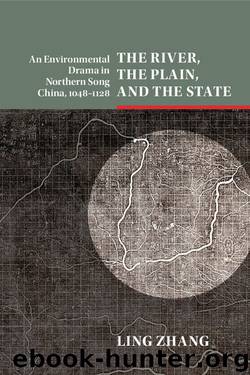The River, the Plain, and the State by Ling Zhang

Author:Ling Zhang
Language: eng
Format: azw3
ISBN: 9781107155985
Publisher: Cambridge University Press
Published: 2016-09-09T04:00:00+00:00
Environmental and Economic Impact of the Ponds
Despite the century-long costly efforts to construct and maintain the ponds, the strategic value of the ponds was never tested by war during the Song period. Despite the brief tensions between the Song and the Liao in the 1040s and the early 1070s, the Liao never attempted a real attack, although we cannot say whether or not the absence of war was because of the Khitan's awareness and fear of the ponds.
The real test of the ponds did not come until the end of the dynasty, when the Jurchen marched southward into northern Hebei in 1125. We have no historical record indicating how the Jurchen dealt with Hebei's watery landscape and if the ponds caused them trouble or deterred their expedition, but it appears that the Jurchen encountered few obstacles as they crossed the Juma River and conquered central Hebei rapidly. Not only did the Song troops collapse immediately in front of the Jurchen's strong assault, but the ponds that the troops relied upon soon fell under the Jurchen's occupation. In retrospect, the suspicion of the usefulness of the ponds held by those like Sima Guang turned out to be correct. Still, although not effective as a military defense as the state and Hebei's officials and officers wished, the ponds indeed cast enormous influence on Hebei. Their existence – expansion and shrinkage – led to a set of unexpected changes to Hebei's environmental conditions and the economic life of Hebei natives.
Imagine a time-lapse bird's-eye view of northern Hebei from the late tenth century through the first quarter of the twelfth century. Skirted by the Juma River, the land first consists of extensive dry farms and patches of disconnected small swamps and lakes. Over time, an increasing number of wet areas begin appearing. This watery surface continues to enlarge, and by the 1030s it appears like a watery belt that covers the eastern half of the Song–Liao border and connects with the vast coastal swamps by the Bohai Gulf. Despite its temporary shrinkage, by the late 1070s, this watery belt has extended westward to cover more than two-thirds of the entire frontier, over four hundred kilometers and only missing from the mountainous terrain in the west. So how did this change in landscape and ponds’ spatial expansion affect the people, flora, and fauna in this area?
In Xiongzhou, where the pond construction began, the land presented stunningly beautiful scenery. Where the ponds stretched several tens of li, lotus flowers blossomed in the summer and waterfowl gathered on the shores. When He Chengju was the prefect here in the late tenth century, he took pleasure rides on small boats with his fellow officials, drinking wine and reciting poems. “Even the land in the lower Yangtze valley (jiangxiang 江鄉) does not have such scenery,” commented a contemporary.59 Similar appreciation was dedicated to the watery landscape in Dingzhou in the late 1070s, after Shen Gua and his fellow officials transformed the vicinity of the prefecture seat into ponds and streams.
Download
This site does not store any files on its server. We only index and link to content provided by other sites. Please contact the content providers to delete copyright contents if any and email us, we'll remove relevant links or contents immediately.
| Africa | Americas |
| Arctic & Antarctica | Asia |
| Australia & Oceania | Europe |
| Middle East | Russia |
| United States | World |
| Ancient Civilizations | Military |
| Historical Study & Educational Resources |
Mediterranean Winter by Robert D. Kaplan(842)
Rivers of Power by Laurence C. Smith(835)
Berezina by Sylvain Tesson(724)
Earth: An Intimate History by Richard Fortey(715)
The Revenge of Geography: What the Map Tells Us About Coming Conflicts and the Battle Against Fate by Robert D. Kaplan(546)
Restigouche by Philip Lee(532)
Exceptional Mountains by O. Alan Weltzien(528)
Hidden Histories by Mary-Ann Ochota(490)
The Coral Island: A Tale of the Pacific Ocean by R. M. Ballantyne(488)
Heaven's Breath by Lyall Watson(479)
Position Doubtful: Mapping Landscapes and Memories by Kim Mahood(445)
The Ancient Paths by Graham Robb(442)
Cartographies of Time by Daniel Rosenberg & Anthony Grafton(423)
Delphi Complete Works of Strabo - Geography (Illustrated) (Delphi Ancient Classics Book 61) by of Amaseia Strabo(418)
Time and Navigation by Andrew K. Johnston(402)
Nature's Mutiny by Phillip Blom(391)
The Oxford Illustrated History of the Holy Land by Robert G. Hoyland & H. G. M. Williamson(375)
A Short History of the World in 50 Places by Jacob F. Field(371)
Putting Science in Its Place by Livingstone David N(360)
